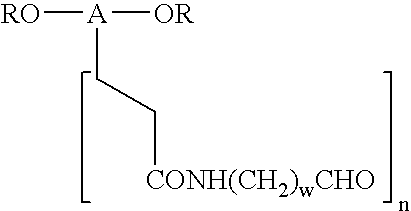Novel monofunctional polyethylene glycol aldehydes
a polyethylene glycol, monofunctional technology, applied in the direction of peptides, immunoglobulins, organic chemistry, etc., can solve the problems of inability to purify, short in vivo half-life, unstable reagents, etc., and achieve the effect of expensive and time-consuming purification procedures
- Summary
- Abstract
- Description
- Claims
- Application Information
AI Technical Summary
Benefits of technology
Problems solved by technology
Method used
Image
Examples
example 1
Scheme A (Type I-Ai)
[0075] Synthesis of mPEG-amide-propionaldchyde.
[0076] Methoxy PEG-OH (M.W. 20,000, n=452) 1 and potassium t-butoxide were dissolved in t-butyl alcohol and stirred at 60.degree. C. Ethyl bromoacetate was then slowly added and the mixture stirred for another 15 hours at 80-85.degree. C. After filtering the reaction mixture, the solvent was evaporated under reduced pressure. The residue was dissolved in distilled water, washed with diethyl ether, and extracted twice with dichloromethane. The dichloromethane solution was dried over magnesium sulfate and the solvent removed under vacuum. Precipitation was induced by the addition of diethyl ether to the crude residue and the precipitated compound was then filtered and dried under vacuum to give the product 2 as a white powder.
[0077] The mPEG-ethyl acetate was dissolved in 1 N-sodium hydroxide and stirred for 15 hours at room temperature. The reaction mixture was then adjusted to pH 2 with 1 N aqueous HCl and extracted ...
example 2
Scheme B (Type I-Ai)
[0083] Synthesis of mPEG-amide-butyraldehyde
[0084] To 10 g, (1 mmol) of polyethylene glycol propionic acid 1, (MW 10,000, n=226) dissolved in a dry methylene chloride / DMF solution (30 ml / 30 ml) was added pyridine (5 mmol) and pentafluorophenyl trifluoroacetate (1.4 g, 5 mmol) and the reaction allowed to stir at room temperature for 45 minutes. The reaction was then diluted with 200 ml of methylene chloride and washed with 0.1N aqueous HCl (2.times.50 ml). The methylene chloride solution was then dried (MgSO.sub.4) and most of the solvent removed under vacuum. The ester was then precipitated with diethyl ether.
[0085] To the pentafluorophenyl ester 2 (8.5 g.about.0.85 mmol) dissolved in dry methylene chloride (25 ml) there was added 1-amino-4,4-dimethoxybu-tane (0.33 g, 2.5 mmol). The reaction mixture was stirred at room temperature for 2 h and the product precipitated in ether (100 ml). After cooling to 4.degree. C., the crude acetal of formula 3 was collected by ...
example 3
Scheme C (Type I-Aii)
[0087] Synthesis of mPEG-urethane-propionaldchyde.
[0088] Triphosgene (148 mg, 0.5 mmol) in 5 ml of dichloromethane was added slowly to a solution of 10 g of mPEG 1 (0.5 mmol) (MW 20,000, n=452)) dissolved in 30 ml of dichloromethane and the resulting mixture stirred for 15 hours at room temperature. The organic solvent was then removed under vacuum and the residue washed with dry ether and filtered. The acid chloride was then dissolved in 30 ml of dry dichloromethane and treated with 80 mg (0.7 mmol) of N-hydroxysuccinimide followed by triethylamine (71 mg, 0.1 ml). After 3 hours, the solution was filtered and evaporated to dryness. The residue was dissolved in warm (50.degree. C.) ethyl acetate, and then the solution cooled to 0.degree. C. The resulting precipitate 2 was collected as a white powder, and the product dried under vacuum.
[0089] To a solution of the 5 g (0.25 mmol) of mPEG-succinimidylcarbonate 2 dissolved in 30 ml of dichloromethane was added 1-ami...
PUM
| Property | Measurement | Unit |
|---|---|---|
| molecular weight | aaaaa | aaaaa |
| molecular weight | aaaaa | aaaaa |
| molecular weight | aaaaa | aaaaa |
Abstract
Description
Claims
Application Information
 Login to View More
Login to View More - R&D
- Intellectual Property
- Life Sciences
- Materials
- Tech Scout
- Unparalleled Data Quality
- Higher Quality Content
- 60% Fewer Hallucinations
Browse by: Latest US Patents, China's latest patents, Technical Efficacy Thesaurus, Application Domain, Technology Topic, Popular Technical Reports.
© 2025 PatSnap. All rights reserved.Legal|Privacy policy|Modern Slavery Act Transparency Statement|Sitemap|About US| Contact US: help@patsnap.com



